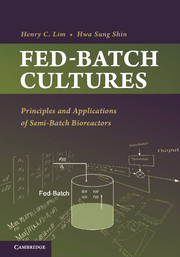Book contents
- Frontmatter
- Contents
- Preface
- Acknowledgments
- 1 Introduction to Fed-Batch Cultures
- 2 Idealized Reactors and Fed-Batch Reactors
- 3 Maximization of Reaction Rates and Fed-Batch Operation
- 4 Phenomena That Favor Fed-Batch Operations
- 5 Classification and Characteristics of Fed-Batch Cultures
- 6 Models Based on Mass Balance Equations
- 7 Non–Equation-Based Models
- 8 Specific Rate Determination
- 9 Optimization by Pontryagin's Maximum Principle
- 10 Computational Techniques
- 11 Optimization of Single and Multiple Reactions
- 12 Optimization for Cell Mass Production
- 13 Optimization for Metabolite Production
- 14 Simple Adaptive Optimization
- 15 Measurements, Estimation, and Control
- 16 Feasibility Assessment and Implementable Feed Rates
- Index
- References
11 - Optimization of Single and Multiple Reactions
Published online by Cambridge University Press: 05 April 2013
- Frontmatter
- Contents
- Preface
- Acknowledgments
- 1 Introduction to Fed-Batch Cultures
- 2 Idealized Reactors and Fed-Batch Reactors
- 3 Maximization of Reaction Rates and Fed-Batch Operation
- 4 Phenomena That Favor Fed-Batch Operations
- 5 Classification and Characteristics of Fed-Batch Cultures
- 6 Models Based on Mass Balance Equations
- 7 Non–Equation-Based Models
- 8 Specific Rate Determination
- 9 Optimization by Pontryagin's Maximum Principle
- 10 Computational Techniques
- 11 Optimization of Single and Multiple Reactions
- 12 Optimization for Cell Mass Production
- 13 Optimization for Metabolite Production
- 14 Simple Adaptive Optimization
- 15 Measurements, Estimation, and Control
- 16 Feasibility Assessment and Implementable Feed Rates
- Index
- References
Summary
In previous chapters, we looked at the basic concept of fed-batch operation as a means of manipulating the feed rate or substrate concentration to maximize the cell growth and product formation rates and harvest only at the end of the operation, not during the operation. Let us first maximize rigorously the conversion of a single reaction of an arbitrary rate expression. Then, we consider the question of the timing of the withdrawal. In the conventional fed-batch operation, the withdrawal is made only at the end of operation and not during the course of operation. Should we withdraw the reaction mixture only at the end of the run? Should we withdraw a part of the culture intermittently or continuously throughout the course of the operation? If the product is harvested all at once only at the end of the run, then the operation is the traditional fed-batch or repeated fed-batch (if a portion of the final reactor content is retained for the next cycle). However, if the product stream is withdrawn during the course in some fashion, then the operation resembles dynamic (variable volume) operation of a continuous-stirred tank reactor (CSTR). By allowing impulse feeding and withdrawal, one can also theoretically mimic temporally the spatial operation of a plug-flow reactor (PFR). Impulse feeding or withdrawal refers to adding or withdrawing a fixed amount instantaneously in the form of an impulse function as one would dump a bucketful of feed in an infinitesimally small time interval. Intuitively, a withdrawal during the course of operation does not change the reaction composition, and therefore, it appears that a withdrawal during the course of operation would not help. To answer this important question, we consider in the following section a rigorous solution to this fundamental question of when to withdraw.
- Type
- Chapter
- Information
- Fed-Batch CulturesPrinciples and Applications of Semi-Batch Bioreactors, pp. 207 - 226Publisher: Cambridge University PressPrint publication year: 2013



